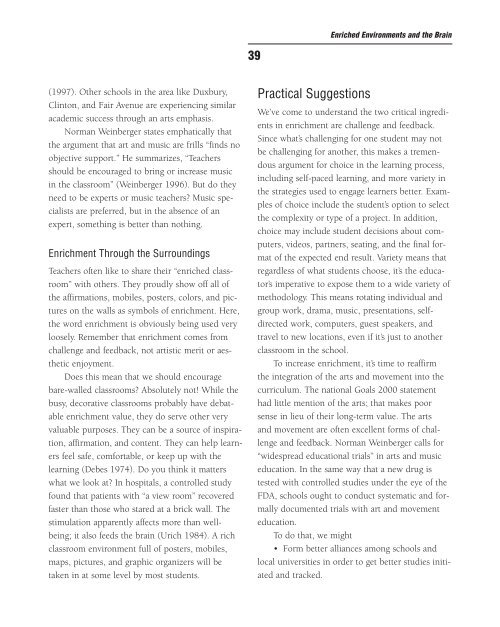Create successful ePaper yourself
Turn your PDF publications into a flip-book with our unique Google optimized e-Paper software.
(1997). O<strong>the</strong>r schools <strong>in</strong> <strong>the</strong> area like Duxbury,<br />
Cl<strong>in</strong>ton, and Fair Avenue are experienc<strong>in</strong>g similar<br />
academic success through an arts emphasis.<br />
Norman We<strong>in</strong>berger states emphatically that<br />
<strong>the</strong> argument that art and music are frills “f<strong>in</strong>ds no<br />
objective support.” He summarizes, “Teachers<br />
should be encouraged to br<strong>in</strong>g or <strong>in</strong>crease music<br />
<strong>in</strong> <strong>the</strong> classroom” (We<strong>in</strong>berger 1996). But do <strong>the</strong>y<br />
need to be experts or music teachers? Music specialists<br />
are preferred, but <strong>in</strong> <strong>the</strong> absence of an<br />
expert, someth<strong>in</strong>g is better than noth<strong>in</strong>g.<br />
Enrichment Through <strong>the</strong> Surround<strong>in</strong>gs<br />
Teachers often like to share <strong>the</strong>ir “enriched classroom”<br />
with o<strong>the</strong>rs. They proudly show off all of<br />
<strong>the</strong> affirmations, mobiles, posters, colors, and pictures<br />
on <strong>the</strong> walls as symbols of enrichment. Here,<br />
<strong>the</strong> word enrichment is obviously be<strong>in</strong>g used very<br />
loosely. Remember that enrichment comes from<br />
challenge and feedback, not artistic merit or aes<strong>the</strong>tic<br />
enjoyment.<br />
Does this mean that we should encourage<br />
bare-walled classrooms? Absolutely not! While <strong>the</strong><br />
busy, decorative classrooms probably have debatable<br />
enrichment value, <strong>the</strong>y do serve o<strong>the</strong>r very<br />
valuable purposes. They can be a source of <strong>in</strong>spiration,<br />
affirmation, and content. They can help learners<br />
feel safe, comfortable, or keep up with <strong>the</strong><br />
learn<strong>in</strong>g (Debes 1974). Do you th<strong>in</strong>k it matters<br />
what we look at? In hospitals, a controlled study<br />
found that patients with “a view room” recovered<br />
faster than those who stared at a brick wall. The<br />
stimulation apparently affects more than wellbe<strong>in</strong>g;<br />
it also feeds <strong>the</strong> bra<strong>in</strong> (Urich 1984). A rich<br />
classroom environment full of posters, mobiles,<br />
maps, pictures, and graphic organizers will be<br />
taken <strong>in</strong> at some level by most students.<br />
39<br />
Practical Suggestions<br />
Enriched Environments and <strong>the</strong> <strong>Bra<strong>in</strong></strong><br />
We’ve come to understand <strong>the</strong> two critical <strong>in</strong>gredients<br />
<strong>in</strong> enrichment are challenge and feedback.<br />
S<strong>in</strong>ce what’s challeng<strong>in</strong>g for one student may not<br />
be challeng<strong>in</strong>g for ano<strong>the</strong>r, this makes a tremendous<br />
argument for choice <strong>in</strong> <strong>the</strong> learn<strong>in</strong>g process,<br />
<strong>in</strong>clud<strong>in</strong>g self-paced learn<strong>in</strong>g, and more variety <strong>in</strong><br />
<strong>the</strong> strategies used to engage learners better. Examples<br />
of choice <strong>in</strong>clude <strong>the</strong> student’s option to select<br />
<strong>the</strong> complexity or type of a project. In addition,<br />
choice may <strong>in</strong>clude student decisions about computers,<br />
videos, partners, seat<strong>in</strong>g, and <strong>the</strong> f<strong>in</strong>al format<br />
of <strong>the</strong> expected end result. Variety means that<br />
regardless of what students choose, it’s <strong>the</strong> educator’s<br />
imperative to expose <strong>the</strong>m to a wide variety of<br />
methodology. This means rotat<strong>in</strong>g <strong>in</strong>dividual and<br />
group work, drama, music, presentations, selfdirected<br />
work, computers, guest speakers, and<br />
travel to new locations, even if it’s just to ano<strong>the</strong>r<br />
classroom <strong>in</strong> <strong>the</strong> school.<br />
To <strong>in</strong>crease enrichment, it’s time to reaffirm<br />
<strong>the</strong> <strong>in</strong>tegration of <strong>the</strong> arts and movement <strong>in</strong>to <strong>the</strong><br />
curriculum. The national Goals 2000 statement<br />
had little mention of <strong>the</strong> arts; that makes poor<br />
sense <strong>in</strong> lieu of <strong>the</strong>ir long-term value. The arts<br />
and movement are often excellent forms of challenge<br />
and feedback. Norman We<strong>in</strong>berger calls for<br />
“widespread educational trials” <strong>in</strong> arts and music<br />
education. In <strong>the</strong> same way that a new drug is<br />
tested with controlled studies under <strong>the</strong> eye of <strong>the</strong><br />
FDA, schools ought to conduct systematic and formally<br />
documented trials with art and movement<br />
education.<br />
To do that, we might<br />
Form better alliances among schools and<br />
local universities <strong>in</strong> order to get better studies <strong>in</strong>itiated<br />
and tracked.



